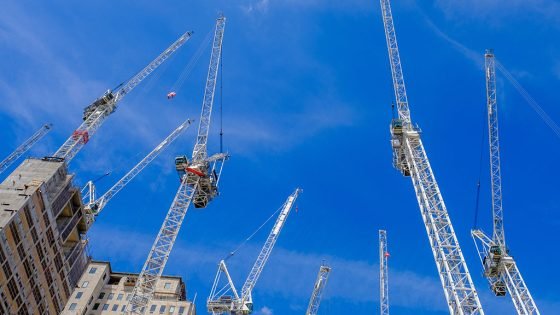Construction activity rose at its fastest pace in three months, according to May purchasing managers’ index (PMI) data.
The S&P Global/CIPS UK Construction PMI, which measures month-on-month changes in total industry activity, came in at 51.6 in May, up from 51.1 in April and above the neutral mark of 50.0 for the fourth consecutive month.
While indicating only modest growth, this latest reading points to the strongest rebound in total construction activity since February.
Growth was driven by commercial and civil engineering activity, with commercial construction (54.2) the best performing segment. Civil engineering also gained momentum (to 53.9), with growth hitting an 11-month high in May.
Total new business rose at a strong pace in May, with the overall increase in construction order letters the strongest since April 2022.
Supply conditions also continued to normalize in May, highlighted by the biggest improvement in supplier delivery times since August 2009. This helped ease cost pressures in the construction sector, with the overall rate of input price inflation falling to its weakest level for 32 months.
Kelly Boorman, partner and national head of construction at RSM UK, described the data as “positive news for the construction industry”.
He said: “Major infrastructure projects are being awarded, which is contributing to the growth in civil engineering activity, future activity and new orders, and also explains the overall pick-up in activity in the sector.
“These projects are ensuring stability for the sector, meaning businesses can continue to plan and procure carefully, while securing employment for skilled workers in the UK and beyond.”
Lloyds Bank’s infrastructure and construction team director Max Jones said: “Contractors are generally optimistic as HS2 and other publicly funded projects provide stability to order books. The industry is also has been driven by demand for commercial projects in city centres, with London reaching a 20-year high.”
However, home building remained the weakest performing activity category, with output declining at the steepest pace in three years. Concerns about the impact of higher interest rates and subdued market conditions continued to dampen activity in this sector.
Work on residential construction projects declined for the sixth consecutive month and at the steepest pace since May 2020. Apart from the pandemic-related decline, the latest reading for this category of construction activity ( 42.7) was the lowest in just over 14 years.
Boorman said the continued decline in housebuilding was “not a surprise” and “highlights the weakness in housing demand as people remain cautious due to interest rates and the cost crisis of life”.
RSM UK economist Thomas Pugh added: “Further falls in house prices look likely as mortgage rates rise again and mortgage approvals, which are a key indicator of demand in real estate market, fell again in April.”
However, he said he did not expect “a big drop in prices”.
Overall, Beard’s chief financial officer Fraser Johns said the industry “should be cautiously optimistic that we appear to have avoided the recession and industry collapse that many predicted at the start of the year” .
However, Johns stressed that despite the “encouraging factors”, the industry was “by no means out of the woods”.
He continued: “Realistic bidding, laser-focused cost control, a renewed emphasis on supplier and stakeholder relationships and the ability to continue to adapt to project demands will remain key as we advance the year”.
Boorman added: “As input price costs and supplier delivery times maintain steady levels of improvement, and inflation and interest rates are expected to fall towards the end of the year, we expect the companies approach 2024 with cautious optimism as they seek to recover margins and improve productivity”.

